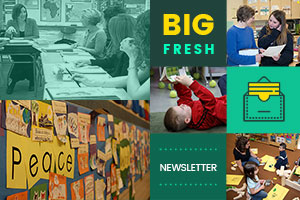Say yes and you’ll figure it out afterwards.
Tina Fey
My friend Ruth and her husband had just returned from watching a five-year-old nephew for a few days. I asked her how it went. “We had such a good time!” she responded. “I was nervous before we left. He’s a charming boy, but we didn’t know him well. That’s a lot of time and uncertainty for a five-year-old. But then I remembered your advice, and just said yes as often as possible to his requests.”
I told Ruth that sounded like great advice, but I had no recollection of ever giving it to her. Ruth reminded me that it came from over two decades earlier. I was coordinating a week-long summer institute for hundreds of people, and Ruth was one of six instructors in it. My baby daughter fell ill the day before the institute began and was in the hospital. Normally I would micromanage everything at an institute I was running. But because I was shuttling between the hospital and the institute, I told the instructors at the orientation meeting, “I know there will be requests you don’t have the answer for, and I won’t always be here to guide you. So just say yes as much as possible. It will make the person happy, and we’ll sort it all out later.”
Honestly, I didn’t care about the trivial concerns that were going to come up from participants—my heart was in that hospital with my daughter, and my body often was too.
It turned out to be a successful week for everyone, mostly because the instructors were wonderful to begin with. But it was a relief for them to be given permission to say yes to any request without getting permission first.
Annual Yes Days have evolved as a tradition in some families based on the fabulous children’s book Yes Day! by Amy Krouse-Rosenthal and Tom Lichtenheld. If you’re a parent or grandparent, you might consider starting the tradition of having a Yes Day with the children you love as a fun break from the routine.
Ruth reminded me that Yes Days are also good when you find yourself in a professional pinch. Giving yourself permission to just say yes frees up so much emotional energy for the bigger challenges you are facing. It wasn’t a big deal for Ruth to say yes to going to the little deli a block from the boy’s house three days in a row for a pizza lunch. She knew overall his diet was healthy, and her visit would be short anyway.
So if you’re overwhelmed with friction and uncertainty, remember the option to just say yes. it is amazing how that one word can smooth over a lot of tensions, if only temporarily.
This week we look at what to teach during that stretch after Thanksgiving and before holiday break that is too short for a complex unit but too long to ignore routines completely. Plus more as always—enjoy!
Brenda Power
Founder, Choice Literacy

Tara Barnett and Kate Mills explain how they avoid a holiday reading slump with students through “break baggies” that include plans developed in the classroom and books selected with peer and teacher input.
Franki Sibberson finds the days before holiday break are the perfect time for talking through with students how to make pleasure reading choices. Her feature includes a template to help students organize and think through their preferences.
People around the world celebrate the holidays in different ways, and that diversity provides wonderful learning opportunities this time of year. Stella Villalba shares literary holiday projects and a booklist around the themes of “peace” and “wishes” that might help students find common ground in family traditions.

New members-only content is added each week to the Choice Literacy website. If you’re not yet a member, click here to explore membership options.
Tara Barnett and Kate Mills take advantage of students’ knowledge of Rudolph the Red-Nosed Reindeer to teach the concept of theme before the holiday break.
Bitsy Parks uses the short stretch before the holidays for a quick and fun how-to writing unit with her first graders.
In an encore video, Ruth Ayres meets with Zoey, a quiet writer who is drawn into the conversation through family stories and a mentor text with vivid illustrations.
Mark Levine finds his middle school students need more time to digest learning from brief articles. Freewriting provides the perfect pause for promoting more reflection and insight.

Lead Literacy now has a new home as the Leaders Lounge at Choice Literacy. We’ll be posting the new content updates here in the Leaders Lounge section of the Big Fresh newsletter.
Matt Renwick buys a new pair of glasses, and gets a stern lecture on taking care of them. The experience makes him ponder what best practice means. He shares a list of his favorite resources for continually refining practice, with many links you might want to explore over the holiday break.
Stephanie Affinito shares strategies for helping teachers build plans and excitement for reading over holiday and summer breaks.
Katherine Sokolowski shares her top ten ways to get children to read over winter break. This would be an excellent link to share with teachers in a professional development session or parents in a newsletter.
Quote It:
Put your ear down close to your soul and listen hard.
Anne Sexton
That’s all for this week!



